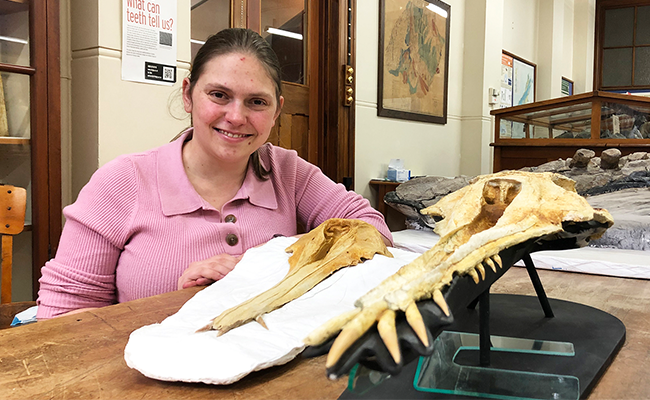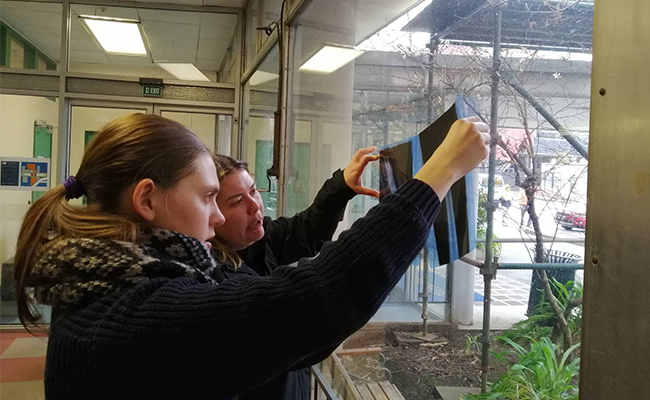Wednesday 29 June 2022 4:05pm

Post-doctoral fellow Amber Coste enjoys working in the University's unique fossil preparation lab. Photo: Guy Frederick.
A 3D scanner funded by a $10,000 post-doctoral grant will allow fossils to be recreated enabling identification of new species from Aotearoa New Zealand. Post-doctoral fellow Amber Coste recently received the money from Hashbane Interactive’s Instinction fund.
Amber’s job is to identify, describe and understand the University’s collection of fossils so information about them can be published and shared internationally.
She uses strontium dating and foram identification to determine their age.
“A lot of them are new species and they have very unusual bits and pieces on their faces which we don’t really know the function of because there’s nothing modern quite like them.”
Looking at brand new species is exciting because you get to name them but a lot of work goes into understanding their anatomy and how to differentiate them from other species before naming comes up, she says.
“It is very much that aspect of ‘Wow, this is something completely unknown. Can I figure out where it fits in the tree of life?’.”
Up until now, fossils have been moulded in silicone and then cast in resin in order to create replicas.
Amber refers to a resin-cast dolphin skull, saying she will be able to replicate similar fossils using 3D modelling instead of going through the “time-consuming, expensive and arduous” process of moulding and casting.
The 3D scanner will enable her to recreate fossils that could not be fully removed from a slab of rock as well as fragile items which should not be handled often.
The dolphin skull was one of the specimens she studied for her PhD which is in the process of being published.
“Soon we will hopefully have three lovely newly named species from the North Otago region of New Zealand.”

Amber says the 3D scanner will make it easier for the geology department to share information about the species found here in Aotearoa New Zealand with other institutions overseas.
Amber has always had a fascination with cetaceans – dolphins and whales - and says she knew since she was 16 years old that she wanted to be an academic.
Initially she started her tertiary career focusing on marine biology but gradually became more interested in the evolution of creatures.
“I found it really, really fascinating that these animals walked around on land millions of years ago and evolved to go back to being 100% aquatic again.”
Dolphins and whales used to be these “strange, four-legged, dog-sized animals” which lived in estuaries, before “deciding” it was easier to get both food and shelter living in water, she says.
“They’re one of the few things that we have that were terrestrial and have gone back to living in the water, that are still around in modern ecosystems.
“It’s just so unusual.”
Another thing she finds fascinating about dolphins is their teeth and how they’ve evolved to eat food without holding on to it.
“They don’t have hands and they don’t have gravity to hold pieces of meat on the floor. It’s just floating around. So they’ve evolved all sorts of rather unusual feeding techniques.”
Amber completed her undergrad and Master’s degrees at the University of Southampton. One of the things that drew Amber to Otago for her PhD was the university’s “incredible collection” of fossils and materials, which she believes is lacking in international recognition.
“I spent my PhD studying three new species of dolphins but I could easily spend the rest of my life here, with other scientists, describing the species that we have here in the basement without ever having to go out to collect more material.”
In addition to the hundreds of specimens the University has, awaiting a keen eye to examine them, was an incredible fossil preparation lab; “I’m fairly sure it’s the only one of its kind that exists in New Zealand”.
This enabled scientists to prepare fossils correctly, keeping them safe from damage.
Amber was also excited by the variety of well preserved, yet-to-be uncovered fossils in Waitaki Valley, which is where most of the University’s specimens come from.
“There’s a huge variety that will help us gain an understanding of how life existed back then. And it’s not just dolphins, we also have penguins, sharks and fish fossils. “
The University of Otago is rare among other universities globally because it has its own fossil collections and students do not have to go through a museum in order to study the specimens.
You can see some of these in the Geology Museum on campus or on loan to Otago Museum.
Kōrero by Koren Allpress, Internal Communications Adviser
